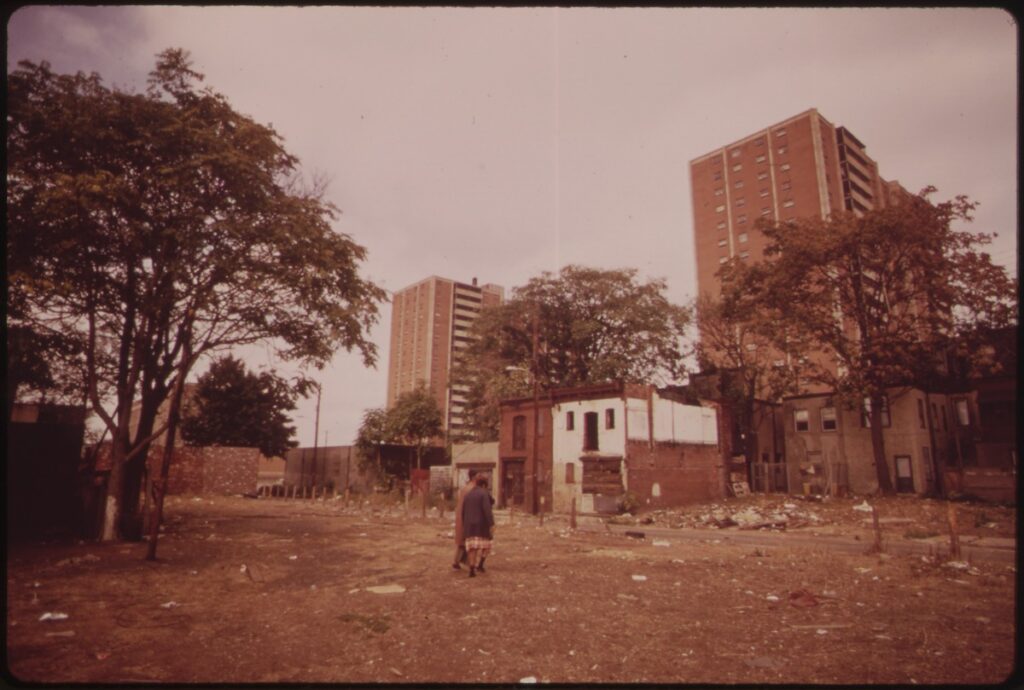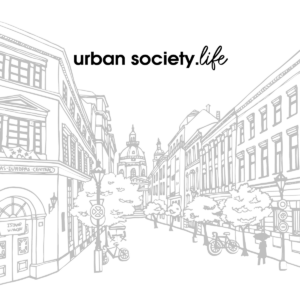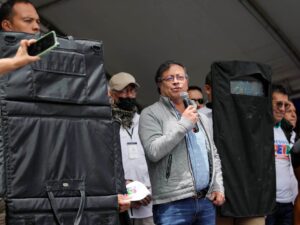Displacing Black Time and Area in Philadelphia

That is your first of three free tales this month. Turn into a free or sustaining member to learn limitless articles, webinars and ebooks.
The next excerpt is tailored from “Dismantling the Grasp’s Clock: On Race, Area, and Time” (AK Press) by Rasheedah Phillips, a lawyer, Afrofuturist author and the director of housing and land justice at PolicyLink.
Gathered with a few hundred others amid the early morning chill of North Philadelphia, I watched as part of town’s historical past was about to be erased. Two out of the three Sharswood-Blumberg towers, which had been a part of the Norman Blumberg Flats, a half-century-old public housing advanced, have been set for demolition on that day in March 2016.
Because the towers imploded after which crumbled, so did a bit of the Sharswood neighborhood’s coronary heart. These buildings, although stigmatized as symbols of poverty and crime, have been house to generations of households. Their destruction was emblematic of a broader, often-overlooked narrative: how city renewal initiatives, pushed by guarantees of progress and revitalization, can perpetuate cycles of displacement and racial inequity.
“Life as we all know it’s going to change,” Philadelphia Housing Authority (PHA) president Kelvin Jeremiah mentioned earlier than the demolition. However at what price to the neighborhood’s material and historical past?

(Courtesy AK Press)
The plan to exchange the towers with new residential and business developments, together with PHA’s new headquarters, was a microcosm of city redevelopment’s impression on communities. It raised vital questions on who advantages from such plans and at whose expense. The acquisition of over 1,300 properties, many by means of eminent area, underscored the stress between improvement and displacement.
Temporalities of gentrification, displacement, and redevelopment in marginalized communities signify a convergence of time, house, and socioeconomic dynamics. These processes usually condense time, accelerating adjustments in the neighborhood material at a tempo that’s disorienting to the established rhythms of life. This speedy transformation can starkly disrupt the shared experiences of time and historical past inside a neighborhood. These communal temporalities are deeply rooted in collective reminiscences, traditions, and the lived experiences of residents, forming a significant a part of the neighborhood’s identification.
Such city redevelopment usually results in the erasure of public reminiscence. Historic buildings, native landmarks, or cultural hubs that maintain communal significance are demolished or repurposed, successfully erasing bodily reminders of the neighborhood’s previous. This loss extends past bodily constructions; it represents a severance of the neighborhood’s connection to its historical past and a disruption within the transmission of collective reminiscences and identities.
These redevelopment processes additionally foreclose entry to the temporal area of the longer term for present residents. Which means as neighborhoods are gentrified, the unique inhabitants usually discover themselves alienated from the longer term improvement of their very own neighborhood. They might face displacement as a consequence of rising residing prices or discover that the evolving neighborhood not displays their cultural and social wants. The intentions behind redevelopment, whether or not for inexpensive housing, market-rate, or luxurious developments, don’t essentially mitigate these temporal disruptions. Even well-intentioned efforts can lead to antagonistic results in the event that they fail to contemplate and respect the prevailing temporalities and histories of the communities concerned.
Philadelphia, which for a few years constantly ranked highest among the many high ten most impoverished huge cities in America, is a spot the place gentrification and racialized segregation have manipulated the panorama of Black communities, working to push residents to the perimeters of town the place they change into locked into temporal-spatial ghettos. Housing instability specifically impacts some areas of town greater than others.
North Philadelphia — the 19121 ZIP code specifically — is the place the best share of town’s poor, Black, and Hispanic residents reside in what known as “racially concentrated poverty.” Additionally it is the place town’s highest ranges of evictions and displacement happen. On this space of town, inequalities associated to poverty are magnified. The poverty charge in Philadelphia in 2016, was 26%; whereas within the 19121 ZIP code the poverty charge was at 52.5%.
Within the 19121 ZIP code, disparities starkly divide the neighborhood. As sure neighborhoods inside the boundaries of 19121 undergo from elevated poverty, poor well being, and crime, different elements are swiftly transitioning by means of gentrification. Deteriorating properties, vacant lands, and uninhabitable properties make land offers low cost for out-of-town builders who then demolish the outdated to erect luxurious dwellings and properties priced effectively above the market common.
As Warren McMichael, a lifelong resident of this ZIP code who grew up on Sharswood Avenue, instructed me of the tempo of North Philly: “I by no means realized it was going to maneuver on the tempo it strikes at now. I believe it strikes quickly. With all the event that’s happening. I personal one other property. I get, each week, playing cards from builders, realtors, wanting to purchase my property.”
Sharswood, a predominantly Black neighborhood, in 2015 grew to become a focus for eminent area and intensive redevelopment initiatives spearheaded by town and the PHA. Sharswood spans an “arrowhead-shaped” locale bounded by Girard and Cecil B. Moore Avenues, stretching from nineteenth to twenty seventh Streets. At its coronary heart as soon as stood three towering high-rises and fifteen low-rise, multi-unit dwellings often known as the Norman Blumberg Flats, inaugurated in 1966 beneath the stewardship of the PHA.
On this compact area, town’s disparities in poverty are accentuated. Whereas Philadelphia’s median family earnings in 2016 stood at $41,449, Sharswood’s median earnings plummeted to $23,790, witnessing a near-28% lower from 1999 to 2013.
In 2013 PHA acquired a grant from the federal Division of Housing and City Growth (HUD), which they used to develop and implement the 2015 Sharswood-Blumberg Neighborhood Transformation Plan, a $500+ million redevelopment mission that concerned the execution of eminent area and demolition of 1,300 properties within the neighborhood and the demolition of two high-rises housing practically 500 households, in addition to a number of dozen low-rise public housing items owned and managed by PHA.
Though new inexpensive housing was desperately wanted within the space as a consequence of important neglect and a backlog of repairs of the general public housing inventory, the plan required owners, renters, and companies to be quickly and completely relocated, whereas historic properties of nice cultural significance have been demolished, offered, or rendered unusable by neglect.
Sharswood’s historic narrative unfurls in opposition to a backdrop of transformative epochs, starting as half of a bigger tract of farmland often known as the Penn District, with Ridge Avenue, its jap boundary, serving as a Lenape path earlier than European settlement. The neighborhood owes its identify to George Sharswood, a Justice of the Supreme Court docket of Pennsylvania who as soon as resided within the space. By the nineteenth century, Sharswood had advanced right into a streetcar suburb providing residence to Irish and German brewery employees (for which the adjoining neighborhood, Brewerytown, is called).
The early twentieth century marked a major demographic shift, with Sharswood changing into a hub for African American tradition in the course of the Nice Migration. Notable residents included James B. Davis of The Dixie Hummingbirds and artist Dox Thrash. The realm round Ridge and Columbia Avenue grew to become famend for its jazz golf equipment and nightlife, attracting legendary musicians like Charlie Parker, John Coltrane, and Odean Pope. The temporary residence of Malcolm X in 1954, throughout his tenure as a minister for the Nation of Islam, additional provides to the neighborhood’s historic significance.
The Norman Blumberg Flats, named for a outstanding Philadelphia AFL-CIO Council chapter president, have been constructed as a mix of three high-rise towers and 15 low-rise house buildings totaling 510 items from 1966–67. The neighborhood had, simply two years earlier than, skilled a riot through which its residents have been successfully reduce off from all assets and had their properties stripped of all worth.
In 1964, throughout a interval of race riots and Black uprisings throughout america, the Columbia Avenue Riot lasted two days and occurred alongside a enterprise and residential district that ran by means of Sharswood. The riot totally devastated what had been a thriving neighborhood of native enterprise house owners, artists, and activists of all backgrounds and ethnicities. A lot of the district’s companies, similar to theaters, grocery shops, eating places, and furnishings shops, couldn’t get better from their losses, and enterprise exercise in North Philadelphia declined.
The neighborhood continued to expertise important challenges, together with a lower in inhabitants, the impacts of deindustrialization, and a discount in financial funding, contributing to its standing as one in every of Philadelphia’s most impoverished areas, characterised by intensive property vacancies and a notably excessive incidence of violent crime.
To an observer from the skin and judging solely by the socioeconomic circumstances of the neighborhood, it could seem as if time stood nonetheless inside the Sharswood neighborhood. The circumstances of the neighborhood in the present day are parallel to the socioeconomic stagnation of Nineteen Sixties North Philadelphia when public housing was first constructed within the space. The socioeconomic backdrop in the course of the 1964 race riots highlights the disparities; the common yearly earnings then was $3,352, about 30% under town’s general common. Unemployment charges fluctuated between 13% and 20%, significantly affecting youth and laborers at a spread of talent ranges.
A extra nuanced scrutiny of the temporal practices inside the neighborhood reveals a deliberate orchestration of intercommunal temporalities — shared communal understandings and negotiations of time that diverge from mainstream linear conceptions. Time has been dynamic on this neighborhood — that’s, till PHA, HUD, Philadelphia Metropolis authorities and different authorities companies started to speed up time by means of the Transformation Plan and the swift, exterior injection of capital over 5 many years too late for the despairing neighborhood. Regardless of the residents’ proactive engagement by means of civil unrest, the civil rights motion, and native organizations, these efforts have been overshadowed by a top-down imposition of time and house that disregarded the neighborhood’s layered temporal tapestry.
City redevelopment and gentrification will not be merely bodily transformations but in addition temporal interventions. They disrupt established temporalities inside communities and impose new temporal orders that prioritize future potentialities aligned with capitalist values. This imposition erases the prevailing temporal narratives of communities and people, particularly these rooted in resistance to capitalist exploitation and marginalization. By seizing areas and predetermining futures, these interventions deny residents the fitting to outline their very own temporalities and futures, successfully erasing their histories and potential legacies.






